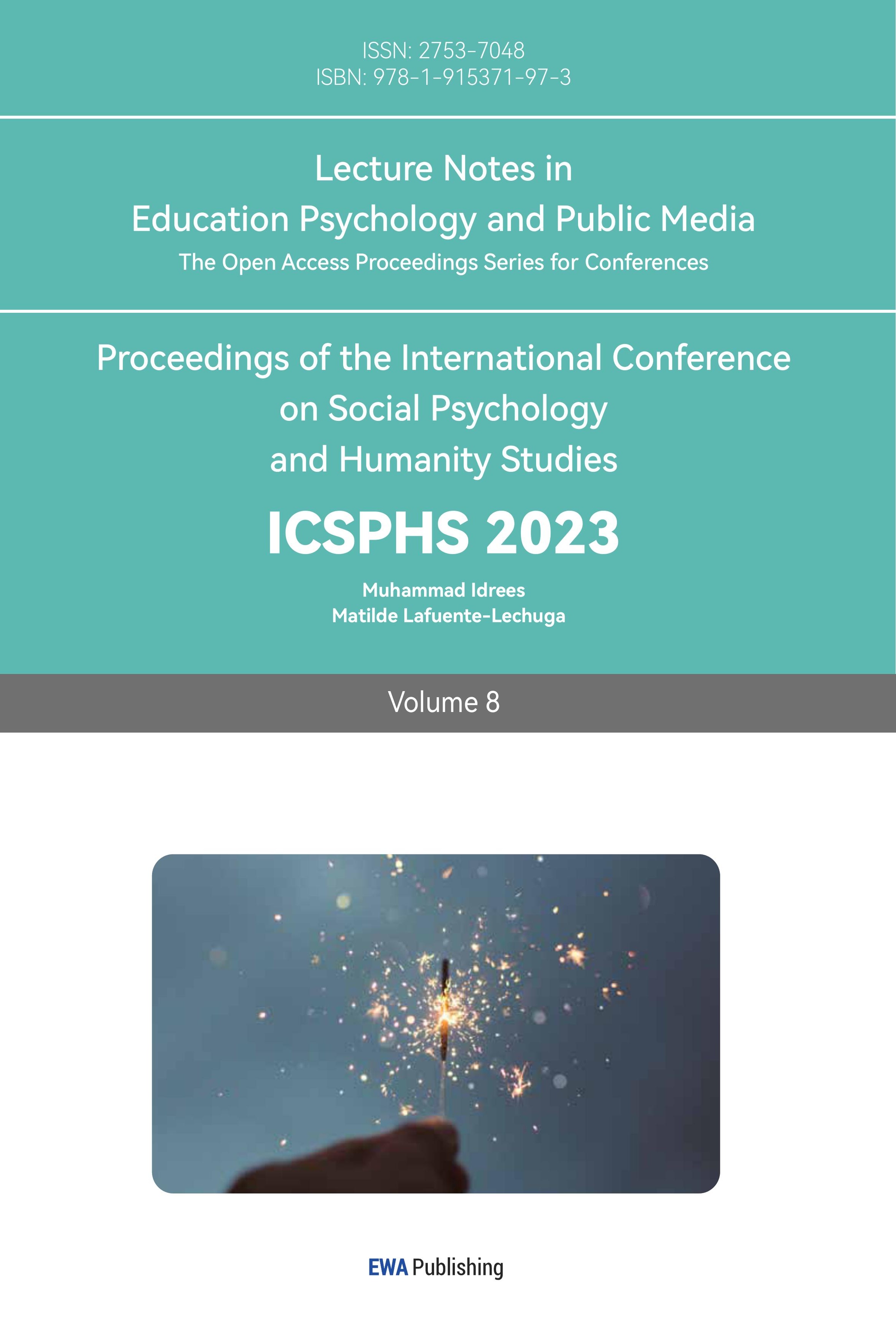References
[1]. Lisa Jardine,"The Renaissance: A Very Short Introduction",Oxford University Press.
[2]. André Chastel,"The Arts of the Renaissance".
[3]. Emma Waterton and Steve Watson,"Heritage: Management, Interpretation, Identity".
[4]. Karol Jan Borowiecki and Neil Forbes,"Cultural Heritage in a Changing World".
[5]. Cabero-Almenara, J., Llorente-Cejudo, C., & Martinez-Roig, R. (2022). The use of mixed, augmented and virtual reality in history of art teaching: A case study. Applied System Innovation, 5(3), 44.
[6]. Knight, J. T. (2013). Bound to Read: Compilations, Collections, and the Making of Renaissance Literature. University of Pennsylvania Press.
[7]. King, M. L. (2003). The renaissance in Europe. Laurence King Publishing.
[8]. Bartoli, G., Betti, M., Blasi, C., Ottoni, F., Coli, M., Marchetti, E., & Ripepe, M. (2016). Synergistic and interdisciplinary approaches for the conservation of monumental heritage: Cupola of Santa Maria del Fiore in Florence, Italy. Journal of Performance of Constructed Facilities, 30(4), 04015091.
[9]. Canuti, C., Carbonari, S., Dall’Asta, A., Dezi, L., Gara, F., Leoni, G., ... & Zona, A. (2021). Post-earthquake damage and vulnerability assessment of churches in the Marche Region struck by the 2016 Central Italy seismic sequence. International Journal of Architectural Heritage, 15(7), 1000-1021.
[10]. Alexander, D. (1995). Newspaper reporting of the May 1993 Florence bomb. International Journal of Mass Emergencies & Disasters, 13(1), 45-65.
[11]. Challenor, J., & Ma, M. (2019). A review of augmented reality applications for history education and heritage visualisation. Multimodal Technologies and Interaction, 3(2), 39.
[12]. Martínez, J. L., Álvarez, S., Finat, J., Delgado, F. J., & Finat, J. (2015). Augmented reality to preserve hidden vestiges in historical cities. A case study. International Archives of the Photogrammetry, Remote Sensing & Spatial Information Sciences.
[13]. Seals, A., Olaosebikan, M., Otiono, J., Shaer, O., & Nov, O. (2021). Effects of self-focused augmented reality on health perceptions during the COVID-19 pandemic: a web-based between-subject experiment. Journal of medical Internet research, 23(6), e26963.
Cite this article
Zhang,S. (2023). Revival of the Material Cultural Relics of the Renaissance by Modern Technology. Lecture Notes in Education Psychology and Public Media,8,368-372.
Data availability
The datasets used and/or analyzed during the current study will be available from the authors upon reasonable request.
Disclaimer/Publisher's Note
The statements, opinions and data contained in all publications are solely those of the individual author(s) and contributor(s) and not of EWA Publishing and/or the editor(s). EWA Publishing and/or the editor(s) disclaim responsibility for any injury to people or property resulting from any ideas, methods, instructions or products referred to in the content.
About volume
Volume title: Proceedings of the International Conference on Social Psychology and Humanity Studies
© 2024 by the author(s). Licensee EWA Publishing, Oxford, UK. This article is an open access article distributed under the terms and
conditions of the Creative Commons Attribution (CC BY) license. Authors who
publish this series agree to the following terms:
1. Authors retain copyright and grant the series right of first publication with the work simultaneously licensed under a Creative Commons
Attribution License that allows others to share the work with an acknowledgment of the work's authorship and initial publication in this
series.
2. Authors are able to enter into separate, additional contractual arrangements for the non-exclusive distribution of the series's published
version of the work (e.g., post it to an institutional repository or publish it in a book), with an acknowledgment of its initial
publication in this series.
3. Authors are permitted and encouraged to post their work online (e.g., in institutional repositories or on their website) prior to and
during the submission process, as it can lead to productive exchanges, as well as earlier and greater citation of published work (See
Open access policy for details).
References
[1]. Lisa Jardine,"The Renaissance: A Very Short Introduction",Oxford University Press.
[2]. André Chastel,"The Arts of the Renaissance".
[3]. Emma Waterton and Steve Watson,"Heritage: Management, Interpretation, Identity".
[4]. Karol Jan Borowiecki and Neil Forbes,"Cultural Heritage in a Changing World".
[5]. Cabero-Almenara, J., Llorente-Cejudo, C., & Martinez-Roig, R. (2022). The use of mixed, augmented and virtual reality in history of art teaching: A case study. Applied System Innovation, 5(3), 44.
[6]. Knight, J. T. (2013). Bound to Read: Compilations, Collections, and the Making of Renaissance Literature. University of Pennsylvania Press.
[7]. King, M. L. (2003). The renaissance in Europe. Laurence King Publishing.
[8]. Bartoli, G., Betti, M., Blasi, C., Ottoni, F., Coli, M., Marchetti, E., & Ripepe, M. (2016). Synergistic and interdisciplinary approaches for the conservation of monumental heritage: Cupola of Santa Maria del Fiore in Florence, Italy. Journal of Performance of Constructed Facilities, 30(4), 04015091.
[9]. Canuti, C., Carbonari, S., Dall’Asta, A., Dezi, L., Gara, F., Leoni, G., ... & Zona, A. (2021). Post-earthquake damage and vulnerability assessment of churches in the Marche Region struck by the 2016 Central Italy seismic sequence. International Journal of Architectural Heritage, 15(7), 1000-1021.
[10]. Alexander, D. (1995). Newspaper reporting of the May 1993 Florence bomb. International Journal of Mass Emergencies & Disasters, 13(1), 45-65.
[11]. Challenor, J., & Ma, M. (2019). A review of augmented reality applications for history education and heritage visualisation. Multimodal Technologies and Interaction, 3(2), 39.
[12]. Martínez, J. L., Álvarez, S., Finat, J., Delgado, F. J., & Finat, J. (2015). Augmented reality to preserve hidden vestiges in historical cities. A case study. International Archives of the Photogrammetry, Remote Sensing & Spatial Information Sciences.
[13]. Seals, A., Olaosebikan, M., Otiono, J., Shaer, O., & Nov, O. (2021). Effects of self-focused augmented reality on health perceptions during the COVID-19 pandemic: a web-based between-subject experiment. Journal of medical Internet research, 23(6), e26963.









